Marketing and Management Report: GlaxoSmithKline's Business Model
VerifiedAdded on 2023/04/20
|13
|3575
|202
Report
AI Summary
This marketing management report focuses on GlaxoSmithKline's (GSK) potential entry into the cannabis medicine market. It begins with an overview of GSK and the changing business landscape due to globalization and technological advancements. The report proposes a business model idea, suggesting the use of a gig economy model to support the new line of disruptive products. It identifies the target segment as individuals suffering from chronic pain and discusses emerging business partners. Furthermore, it outlines the unique selling proposition (USP) of cannabis medicines for both the target segment and business partners, emphasizing cost-effectiveness and potential efficacy. A marketing campaign using social and ethical marketing is suggested. The report concludes by analyzing the changing social and ethical environment and its implications for GSK's marketing strategy. References are provided for supporting the arguments.
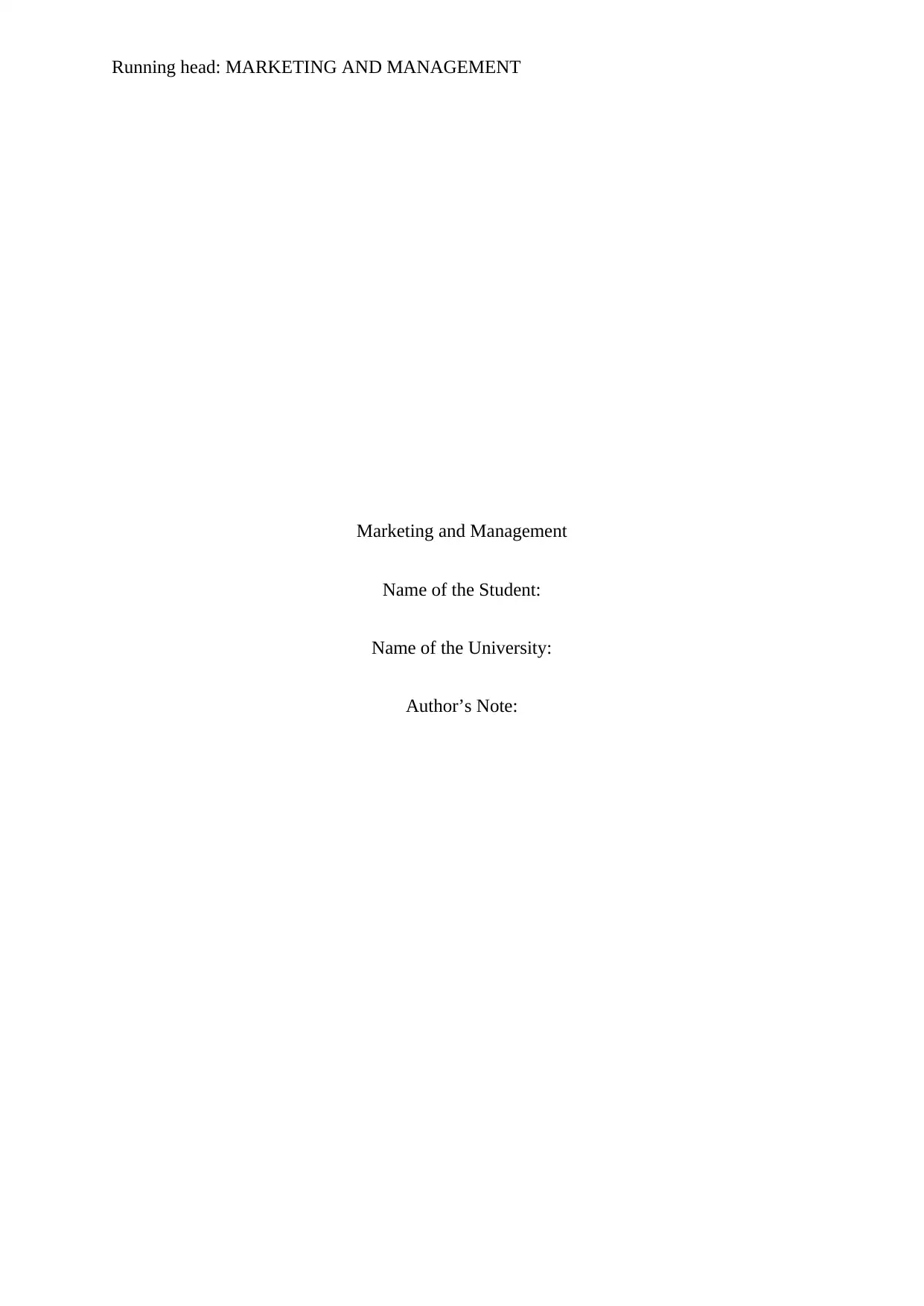
Running head: MARKETING AND MANAGEMENT
Marketing and Management
Name of the Student:
Name of the University:
Author’s Note:
Marketing and Management
Name of the Student:
Name of the University:
Author’s Note:
Paraphrase This Document
Need a fresh take? Get an instant paraphrase of this document with our AI Paraphraser
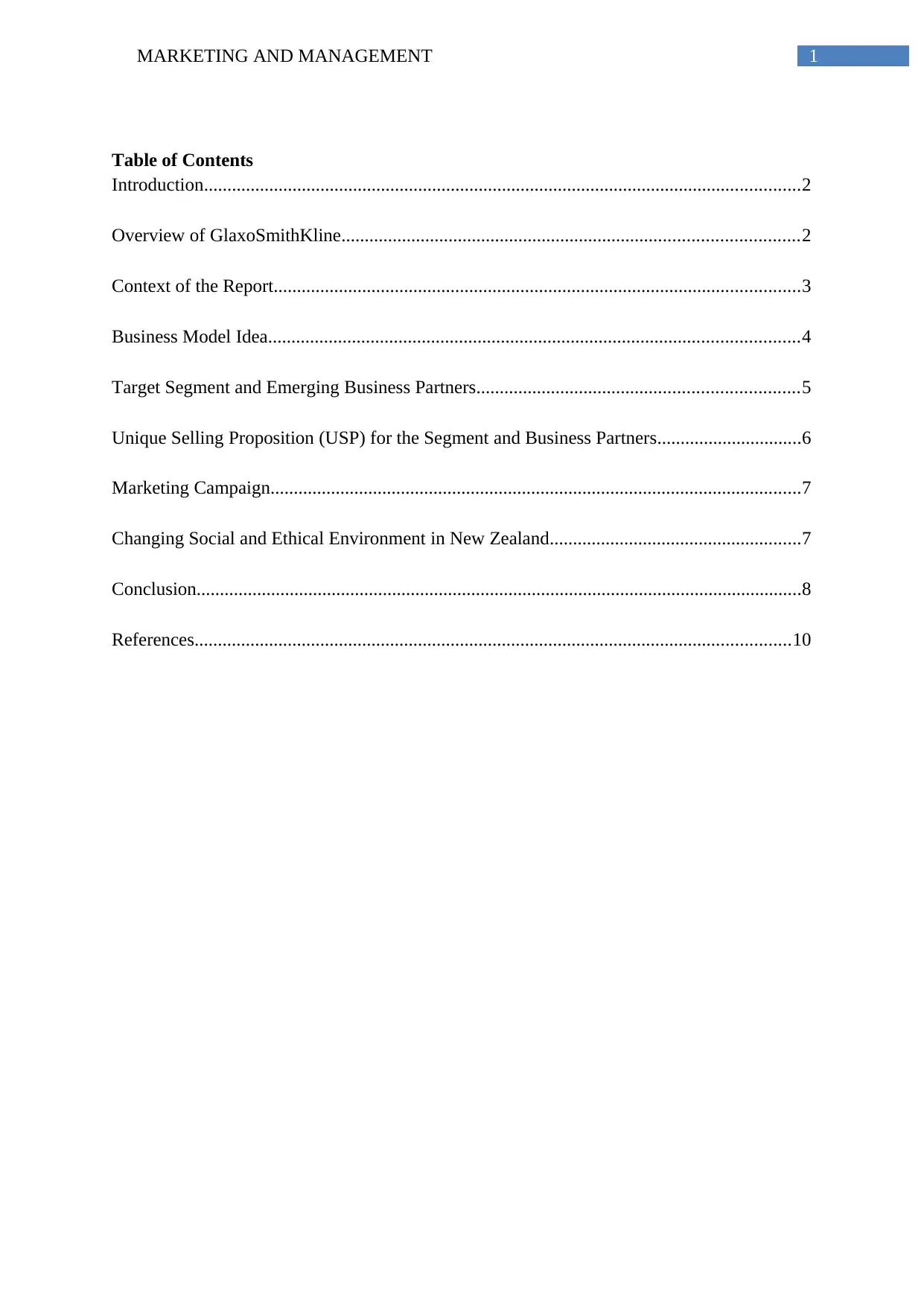
1MARKETING AND MANAGEMENT
Table of Contents
Introduction................................................................................................................................2
Overview of GlaxoSmithKline..................................................................................................2
Context of the Report.................................................................................................................3
Business Model Idea..................................................................................................................4
Target Segment and Emerging Business Partners.....................................................................5
Unique Selling Proposition (USP) for the Segment and Business Partners...............................6
Marketing Campaign..................................................................................................................7
Changing Social and Ethical Environment in New Zealand......................................................7
Conclusion..................................................................................................................................8
References................................................................................................................................10
Table of Contents
Introduction................................................................................................................................2
Overview of GlaxoSmithKline..................................................................................................2
Context of the Report.................................................................................................................3
Business Model Idea..................................................................................................................4
Target Segment and Emerging Business Partners.....................................................................5
Unique Selling Proposition (USP) for the Segment and Business Partners...............................6
Marketing Campaign..................................................................................................................7
Changing Social and Ethical Environment in New Zealand......................................................7
Conclusion..................................................................................................................................8
References................................................................................................................................10
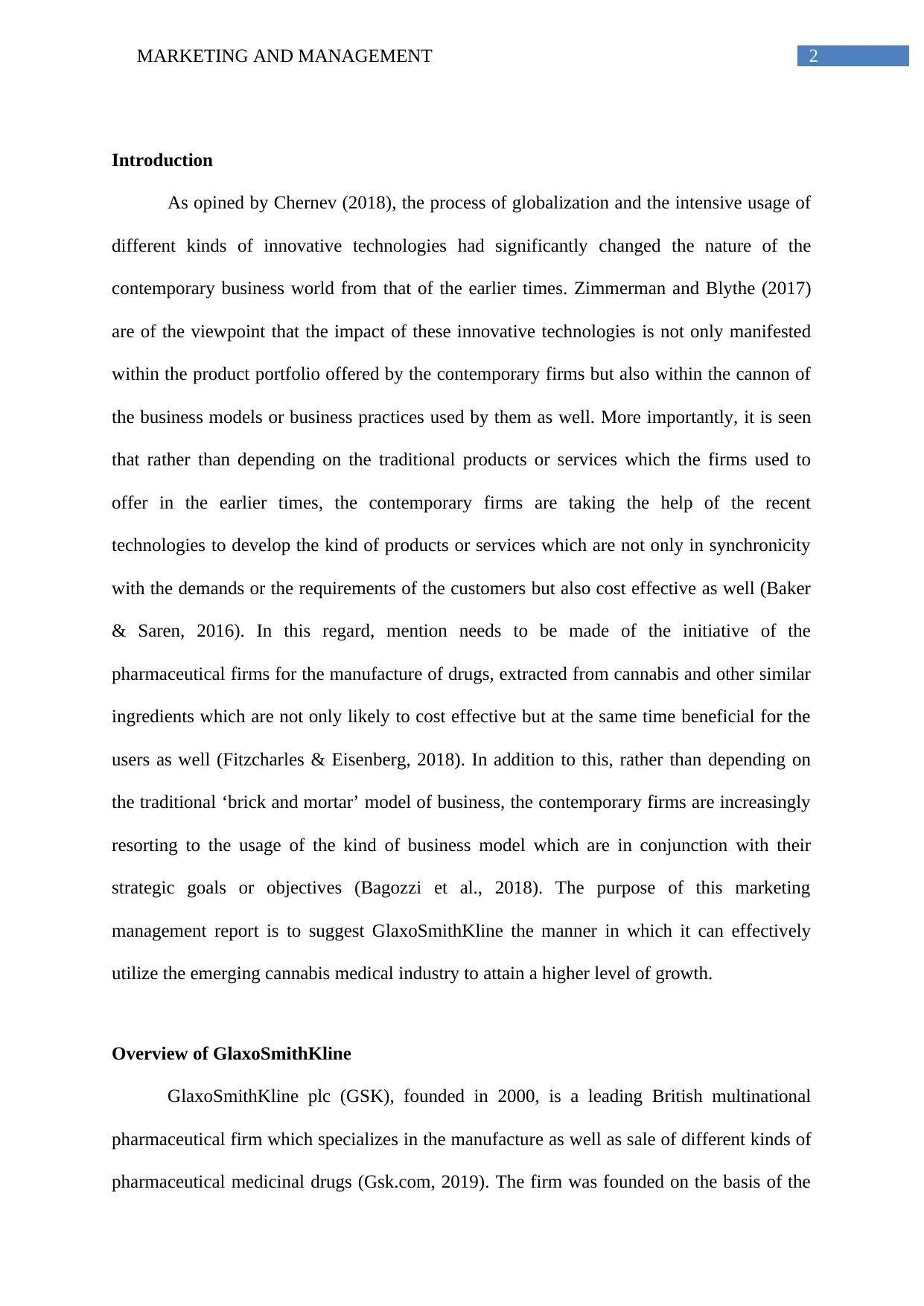
2MARKETING AND MANAGEMENT
Introduction
As opined by Chernev (2018), the process of globalization and the intensive usage of
different kinds of innovative technologies had significantly changed the nature of the
contemporary business world from that of the earlier times. Zimmerman and Blythe (2017)
are of the viewpoint that the impact of these innovative technologies is not only manifested
within the product portfolio offered by the contemporary firms but also within the cannon of
the business models or business practices used by them as well. More importantly, it is seen
that rather than depending on the traditional products or services which the firms used to
offer in the earlier times, the contemporary firms are taking the help of the recent
technologies to develop the kind of products or services which are not only in synchronicity
with the demands or the requirements of the customers but also cost effective as well (Baker
& Saren, 2016). In this regard, mention needs to be made of the initiative of the
pharmaceutical firms for the manufacture of drugs, extracted from cannabis and other similar
ingredients which are not only likely to cost effective but at the same time beneficial for the
users as well (Fitzcharles & Eisenberg, 2018). In addition to this, rather than depending on
the traditional ‘brick and mortar’ model of business, the contemporary firms are increasingly
resorting to the usage of the kind of business model which are in conjunction with their
strategic goals or objectives (Bagozzi et al., 2018). The purpose of this marketing
management report is to suggest GlaxoSmithKline the manner in which it can effectively
utilize the emerging cannabis medical industry to attain a higher level of growth.
Overview of GlaxoSmithKline
GlaxoSmithKline plc (GSK), founded in 2000, is a leading British multinational
pharmaceutical firm which specializes in the manufacture as well as sale of different kinds of
pharmaceutical medicinal drugs (Gsk.com, 2019). The firm was founded on the basis of the
Introduction
As opined by Chernev (2018), the process of globalization and the intensive usage of
different kinds of innovative technologies had significantly changed the nature of the
contemporary business world from that of the earlier times. Zimmerman and Blythe (2017)
are of the viewpoint that the impact of these innovative technologies is not only manifested
within the product portfolio offered by the contemporary firms but also within the cannon of
the business models or business practices used by them as well. More importantly, it is seen
that rather than depending on the traditional products or services which the firms used to
offer in the earlier times, the contemporary firms are taking the help of the recent
technologies to develop the kind of products or services which are not only in synchronicity
with the demands or the requirements of the customers but also cost effective as well (Baker
& Saren, 2016). In this regard, mention needs to be made of the initiative of the
pharmaceutical firms for the manufacture of drugs, extracted from cannabis and other similar
ingredients which are not only likely to cost effective but at the same time beneficial for the
users as well (Fitzcharles & Eisenberg, 2018). In addition to this, rather than depending on
the traditional ‘brick and mortar’ model of business, the contemporary firms are increasingly
resorting to the usage of the kind of business model which are in conjunction with their
strategic goals or objectives (Bagozzi et al., 2018). The purpose of this marketing
management report is to suggest GlaxoSmithKline the manner in which it can effectively
utilize the emerging cannabis medical industry to attain a higher level of growth.
Overview of GlaxoSmithKline
GlaxoSmithKline plc (GSK), founded in 2000, is a leading British multinational
pharmaceutical firm which specializes in the manufacture as well as sale of different kinds of
pharmaceutical medicinal drugs (Gsk.com, 2019). The firm was founded on the basis of the
⊘ This is a preview!⊘
Do you want full access?
Subscribe today to unlock all pages.

Trusted by 1+ million students worldwide
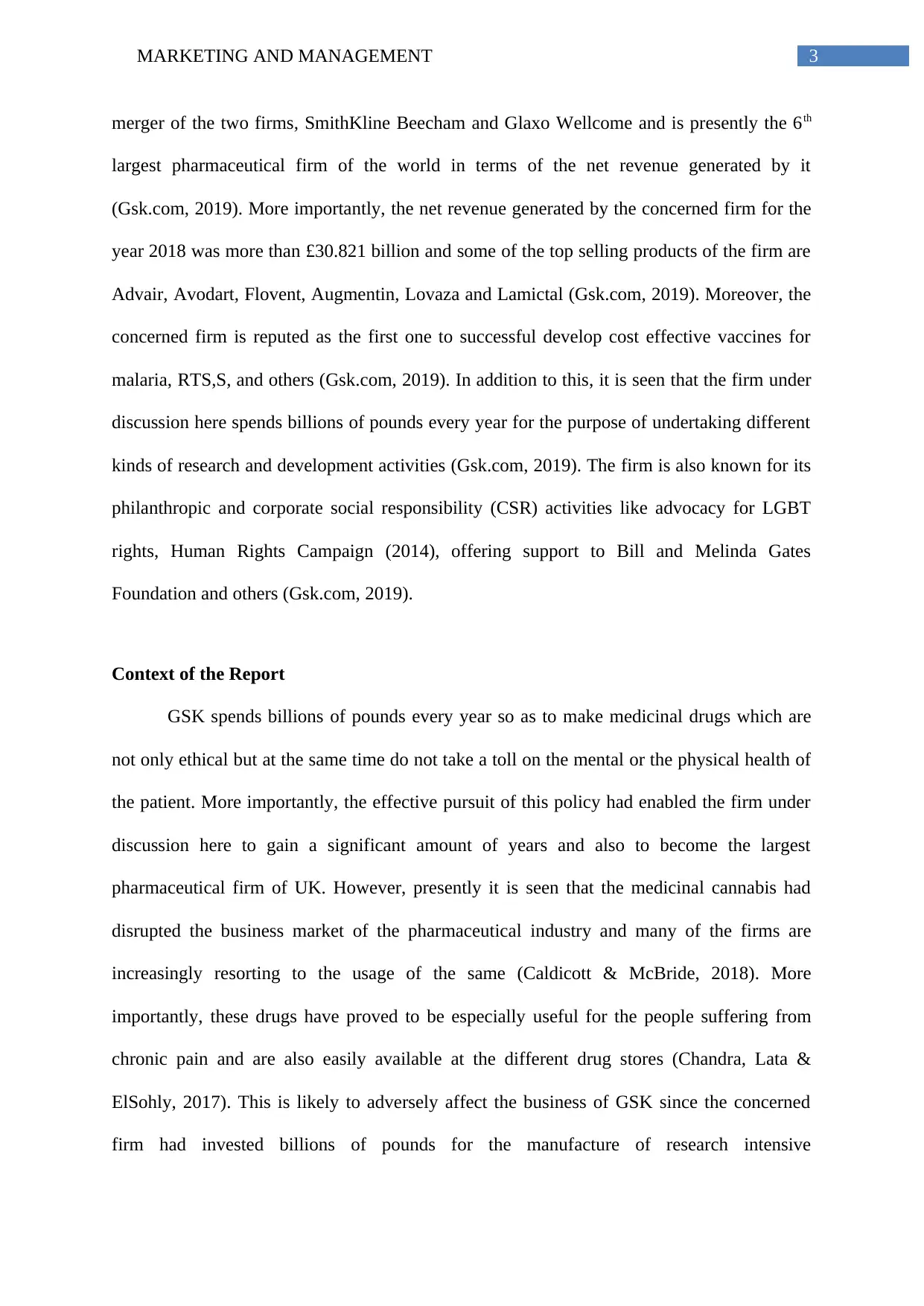
3MARKETING AND MANAGEMENT
merger of the two firms, SmithKline Beecham and Glaxo Wellcome and is presently the 6th
largest pharmaceutical firm of the world in terms of the net revenue generated by it
(Gsk.com, 2019). More importantly, the net revenue generated by the concerned firm for the
year 2018 was more than £30.821 billion and some of the top selling products of the firm are
Advair, Avodart, Flovent, Augmentin, Lovaza and Lamictal (Gsk.com, 2019). Moreover, the
concerned firm is reputed as the first one to successful develop cost effective vaccines for
malaria, RTS,S, and others (Gsk.com, 2019). In addition to this, it is seen that the firm under
discussion here spends billions of pounds every year for the purpose of undertaking different
kinds of research and development activities (Gsk.com, 2019). The firm is also known for its
philanthropic and corporate social responsibility (CSR) activities like advocacy for LGBT
rights, Human Rights Campaign (2014), offering support to Bill and Melinda Gates
Foundation and others (Gsk.com, 2019).
Context of the Report
GSK spends billions of pounds every year so as to make medicinal drugs which are
not only ethical but at the same time do not take a toll on the mental or the physical health of
the patient. More importantly, the effective pursuit of this policy had enabled the firm under
discussion here to gain a significant amount of years and also to become the largest
pharmaceutical firm of UK. However, presently it is seen that the medicinal cannabis had
disrupted the business market of the pharmaceutical industry and many of the firms are
increasingly resorting to the usage of the same (Caldicott & McBride, 2018). More
importantly, these drugs have proved to be especially useful for the people suffering from
chronic pain and are also easily available at the different drug stores (Chandra, Lata &
ElSohly, 2017). This is likely to adversely affect the business of GSK since the concerned
firm had invested billions of pounds for the manufacture of research intensive
merger of the two firms, SmithKline Beecham and Glaxo Wellcome and is presently the 6th
largest pharmaceutical firm of the world in terms of the net revenue generated by it
(Gsk.com, 2019). More importantly, the net revenue generated by the concerned firm for the
year 2018 was more than £30.821 billion and some of the top selling products of the firm are
Advair, Avodart, Flovent, Augmentin, Lovaza and Lamictal (Gsk.com, 2019). Moreover, the
concerned firm is reputed as the first one to successful develop cost effective vaccines for
malaria, RTS,S, and others (Gsk.com, 2019). In addition to this, it is seen that the firm under
discussion here spends billions of pounds every year for the purpose of undertaking different
kinds of research and development activities (Gsk.com, 2019). The firm is also known for its
philanthropic and corporate social responsibility (CSR) activities like advocacy for LGBT
rights, Human Rights Campaign (2014), offering support to Bill and Melinda Gates
Foundation and others (Gsk.com, 2019).
Context of the Report
GSK spends billions of pounds every year so as to make medicinal drugs which are
not only ethical but at the same time do not take a toll on the mental or the physical health of
the patient. More importantly, the effective pursuit of this policy had enabled the firm under
discussion here to gain a significant amount of years and also to become the largest
pharmaceutical firm of UK. However, presently it is seen that the medicinal cannabis had
disrupted the business market of the pharmaceutical industry and many of the firms are
increasingly resorting to the usage of the same (Caldicott & McBride, 2018). More
importantly, these drugs have proved to be especially useful for the people suffering from
chronic pain and are also easily available at the different drug stores (Chandra, Lata &
ElSohly, 2017). This is likely to adversely affect the business of GSK since the concerned
firm had invested billions of pounds for the manufacture of research intensive
Paraphrase This Document
Need a fresh take? Get an instant paraphrase of this document with our AI Paraphraser
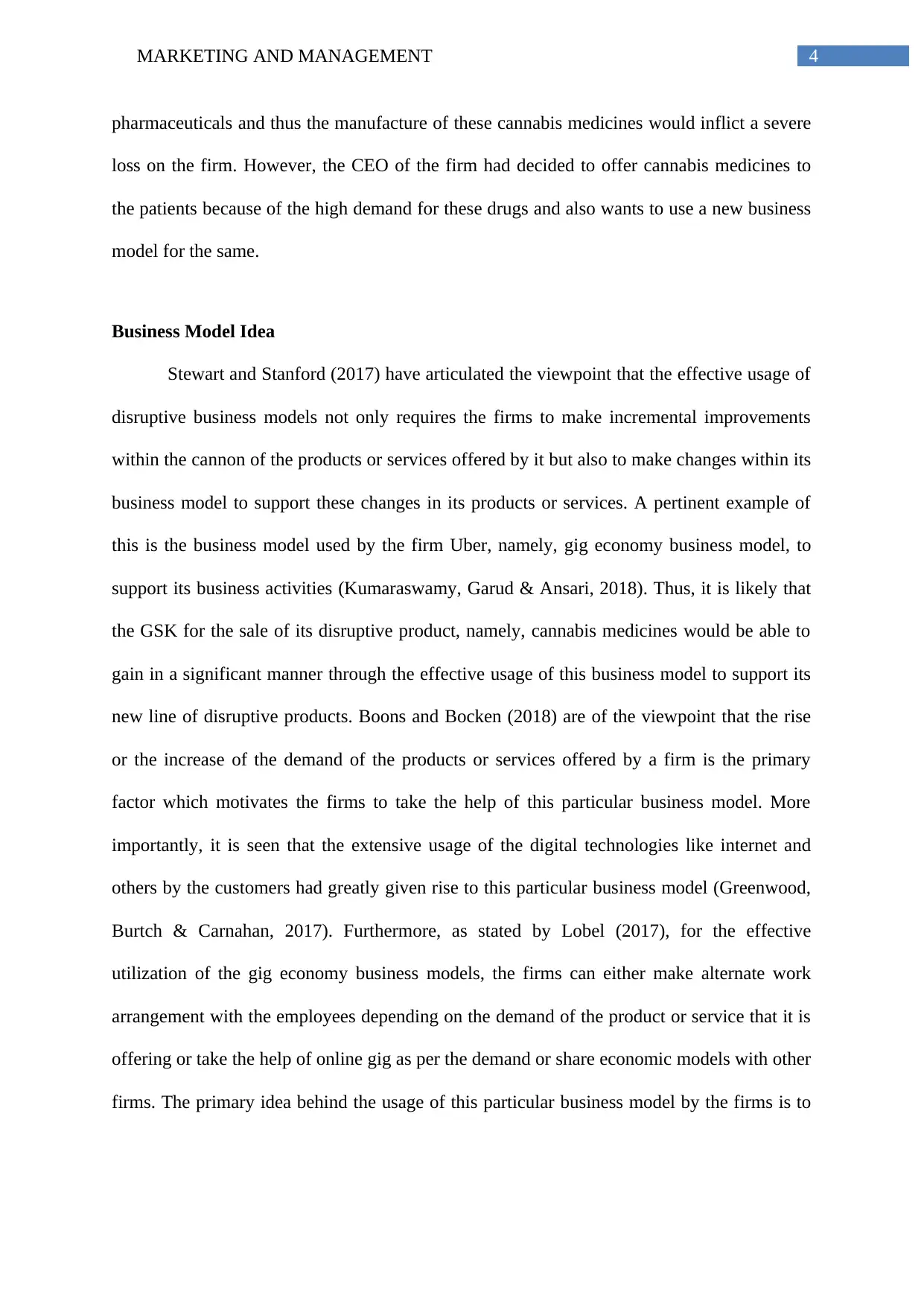
4MARKETING AND MANAGEMENT
pharmaceuticals and thus the manufacture of these cannabis medicines would inflict a severe
loss on the firm. However, the CEO of the firm had decided to offer cannabis medicines to
the patients because of the high demand for these drugs and also wants to use a new business
model for the same.
Business Model Idea
Stewart and Stanford (2017) have articulated the viewpoint that the effective usage of
disruptive business models not only requires the firms to make incremental improvements
within the cannon of the products or services offered by it but also to make changes within its
business model to support these changes in its products or services. A pertinent example of
this is the business model used by the firm Uber, namely, gig economy business model, to
support its business activities (Kumaraswamy, Garud & Ansari, 2018). Thus, it is likely that
the GSK for the sale of its disruptive product, namely, cannabis medicines would be able to
gain in a significant manner through the effective usage of this business model to support its
new line of disruptive products. Boons and Bocken (2018) are of the viewpoint that the rise
or the increase of the demand of the products or services offered by a firm is the primary
factor which motivates the firms to take the help of this particular business model. More
importantly, it is seen that the extensive usage of the digital technologies like internet and
others by the customers had greatly given rise to this particular business model (Greenwood,
Burtch & Carnahan, 2017). Furthermore, as stated by Lobel (2017), for the effective
utilization of the gig economy business models, the firms can either make alternate work
arrangement with the employees depending on the demand of the product or service that it is
offering or take the help of online gig as per the demand or share economic models with other
firms. The primary idea behind the usage of this particular business model by the firms is to
pharmaceuticals and thus the manufacture of these cannabis medicines would inflict a severe
loss on the firm. However, the CEO of the firm had decided to offer cannabis medicines to
the patients because of the high demand for these drugs and also wants to use a new business
model for the same.
Business Model Idea
Stewart and Stanford (2017) have articulated the viewpoint that the effective usage of
disruptive business models not only requires the firms to make incremental improvements
within the cannon of the products or services offered by it but also to make changes within its
business model to support these changes in its products or services. A pertinent example of
this is the business model used by the firm Uber, namely, gig economy business model, to
support its business activities (Kumaraswamy, Garud & Ansari, 2018). Thus, it is likely that
the GSK for the sale of its disruptive product, namely, cannabis medicines would be able to
gain in a significant manner through the effective usage of this business model to support its
new line of disruptive products. Boons and Bocken (2018) are of the viewpoint that the rise
or the increase of the demand of the products or services offered by a firm is the primary
factor which motivates the firms to take the help of this particular business model. More
importantly, it is seen that the extensive usage of the digital technologies like internet and
others by the customers had greatly given rise to this particular business model (Greenwood,
Burtch & Carnahan, 2017). Furthermore, as stated by Lobel (2017), for the effective
utilization of the gig economy business models, the firms can either make alternate work
arrangement with the employees depending on the demand of the product or service that it is
offering or take the help of online gig as per the demand or share economic models with other
firms. The primary idea behind the usage of this particular business model by the firms is to
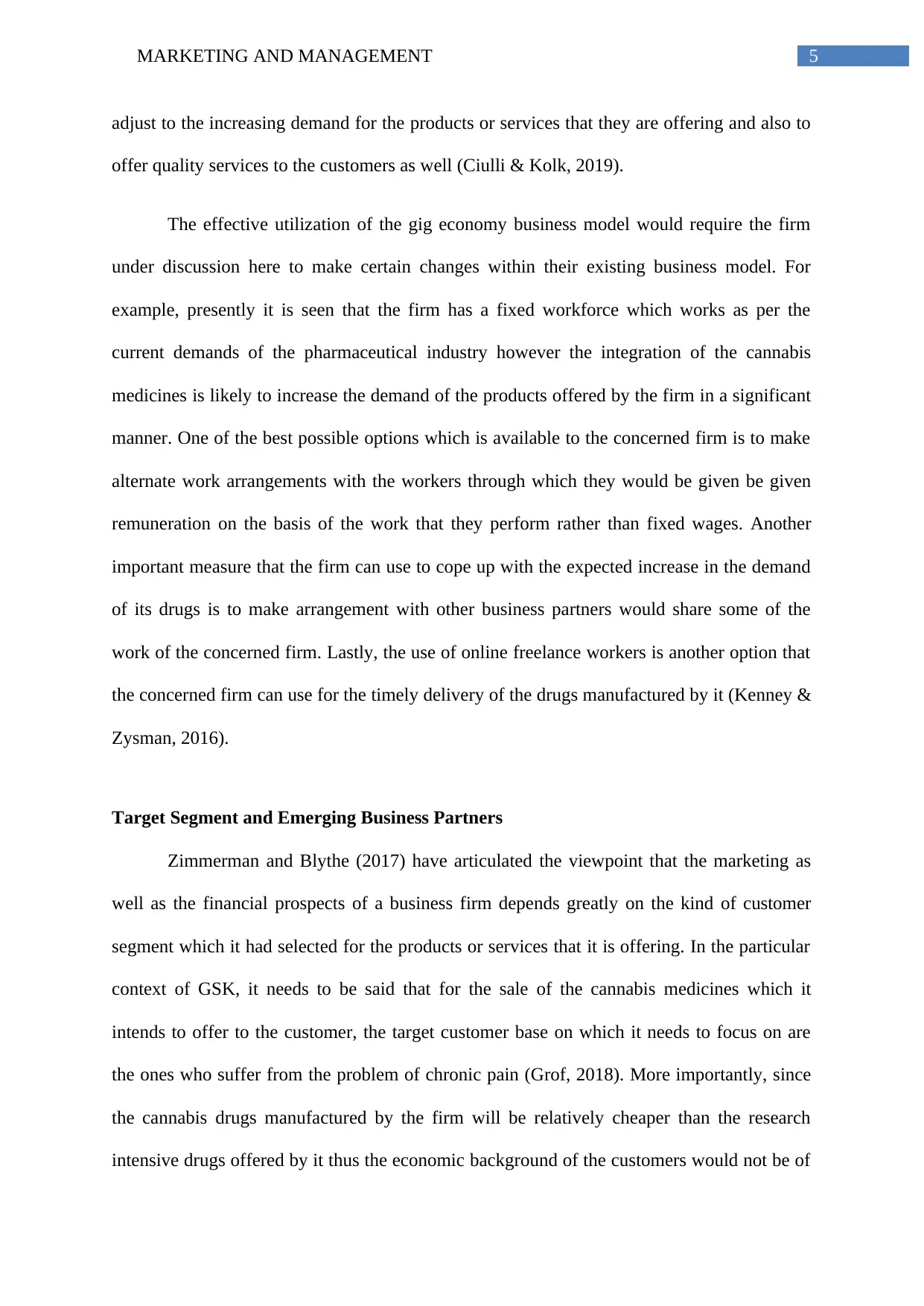
5MARKETING AND MANAGEMENT
adjust to the increasing demand for the products or services that they are offering and also to
offer quality services to the customers as well (Ciulli & Kolk, 2019).
The effective utilization of the gig economy business model would require the firm
under discussion here to make certain changes within their existing business model. For
example, presently it is seen that the firm has a fixed workforce which works as per the
current demands of the pharmaceutical industry however the integration of the cannabis
medicines is likely to increase the demand of the products offered by the firm in a significant
manner. One of the best possible options which is available to the concerned firm is to make
alternate work arrangements with the workers through which they would be given be given
remuneration on the basis of the work that they perform rather than fixed wages. Another
important measure that the firm can use to cope up with the expected increase in the demand
of its drugs is to make arrangement with other business partners would share some of the
work of the concerned firm. Lastly, the use of online freelance workers is another option that
the concerned firm can use for the timely delivery of the drugs manufactured by it (Kenney &
Zysman, 2016).
Target Segment and Emerging Business Partners
Zimmerman and Blythe (2017) have articulated the viewpoint that the marketing as
well as the financial prospects of a business firm depends greatly on the kind of customer
segment which it had selected for the products or services that it is offering. In the particular
context of GSK, it needs to be said that for the sale of the cannabis medicines which it
intends to offer to the customer, the target customer base on which it needs to focus on are
the ones who suffer from the problem of chronic pain (Grof, 2018). More importantly, since
the cannabis drugs manufactured by the firm will be relatively cheaper than the research
intensive drugs offered by it thus the economic background of the customers would not be of
adjust to the increasing demand for the products or services that they are offering and also to
offer quality services to the customers as well (Ciulli & Kolk, 2019).
The effective utilization of the gig economy business model would require the firm
under discussion here to make certain changes within their existing business model. For
example, presently it is seen that the firm has a fixed workforce which works as per the
current demands of the pharmaceutical industry however the integration of the cannabis
medicines is likely to increase the demand of the products offered by the firm in a significant
manner. One of the best possible options which is available to the concerned firm is to make
alternate work arrangements with the workers through which they would be given be given
remuneration on the basis of the work that they perform rather than fixed wages. Another
important measure that the firm can use to cope up with the expected increase in the demand
of its drugs is to make arrangement with other business partners would share some of the
work of the concerned firm. Lastly, the use of online freelance workers is another option that
the concerned firm can use for the timely delivery of the drugs manufactured by it (Kenney &
Zysman, 2016).
Target Segment and Emerging Business Partners
Zimmerman and Blythe (2017) have articulated the viewpoint that the marketing as
well as the financial prospects of a business firm depends greatly on the kind of customer
segment which it had selected for the products or services that it is offering. In the particular
context of GSK, it needs to be said that for the sale of the cannabis medicines which it
intends to offer to the customer, the target customer base on which it needs to focus on are
the ones who suffer from the problem of chronic pain (Grof, 2018). More importantly, since
the cannabis drugs manufactured by the firm will be relatively cheaper than the research
intensive drugs offered by it thus the economic background of the customers would not be of
⊘ This is a preview!⊘
Do you want full access?
Subscribe today to unlock all pages.

Trusted by 1+ million students worldwide
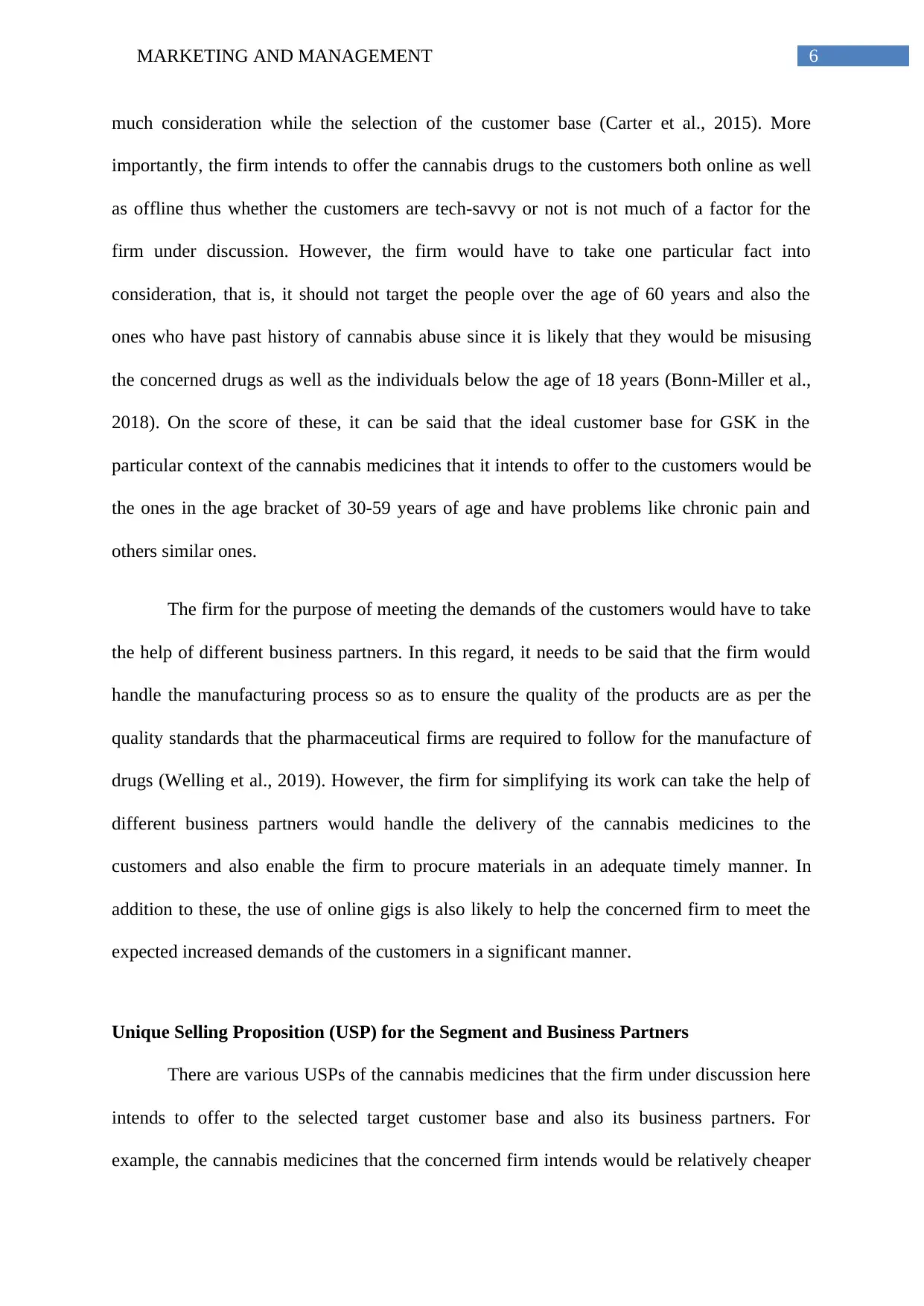
6MARKETING AND MANAGEMENT
much consideration while the selection of the customer base (Carter et al., 2015). More
importantly, the firm intends to offer the cannabis drugs to the customers both online as well
as offline thus whether the customers are tech-savvy or not is not much of a factor for the
firm under discussion. However, the firm would have to take one particular fact into
consideration, that is, it should not target the people over the age of 60 years and also the
ones who have past history of cannabis abuse since it is likely that they would be misusing
the concerned drugs as well as the individuals below the age of 18 years (Bonn-Miller et al.,
2018). On the score of these, it can be said that the ideal customer base for GSK in the
particular context of the cannabis medicines that it intends to offer to the customers would be
the ones in the age bracket of 30-59 years of age and have problems like chronic pain and
others similar ones.
The firm for the purpose of meeting the demands of the customers would have to take
the help of different business partners. In this regard, it needs to be said that the firm would
handle the manufacturing process so as to ensure the quality of the products are as per the
quality standards that the pharmaceutical firms are required to follow for the manufacture of
drugs (Welling et al., 2019). However, the firm for simplifying its work can take the help of
different business partners would handle the delivery of the cannabis medicines to the
customers and also enable the firm to procure materials in an adequate timely manner. In
addition to these, the use of online gigs is also likely to help the concerned firm to meet the
expected increased demands of the customers in a significant manner.
Unique Selling Proposition (USP) for the Segment and Business Partners
There are various USPs of the cannabis medicines that the firm under discussion here
intends to offer to the selected target customer base and also its business partners. For
example, the cannabis medicines that the concerned firm intends would be relatively cheaper
much consideration while the selection of the customer base (Carter et al., 2015). More
importantly, the firm intends to offer the cannabis drugs to the customers both online as well
as offline thus whether the customers are tech-savvy or not is not much of a factor for the
firm under discussion. However, the firm would have to take one particular fact into
consideration, that is, it should not target the people over the age of 60 years and also the
ones who have past history of cannabis abuse since it is likely that they would be misusing
the concerned drugs as well as the individuals below the age of 18 years (Bonn-Miller et al.,
2018). On the score of these, it can be said that the ideal customer base for GSK in the
particular context of the cannabis medicines that it intends to offer to the customers would be
the ones in the age bracket of 30-59 years of age and have problems like chronic pain and
others similar ones.
The firm for the purpose of meeting the demands of the customers would have to take
the help of different business partners. In this regard, it needs to be said that the firm would
handle the manufacturing process so as to ensure the quality of the products are as per the
quality standards that the pharmaceutical firms are required to follow for the manufacture of
drugs (Welling et al., 2019). However, the firm for simplifying its work can take the help of
different business partners would handle the delivery of the cannabis medicines to the
customers and also enable the firm to procure materials in an adequate timely manner. In
addition to these, the use of online gigs is also likely to help the concerned firm to meet the
expected increased demands of the customers in a significant manner.
Unique Selling Proposition (USP) for the Segment and Business Partners
There are various USPs of the cannabis medicines that the firm under discussion here
intends to offer to the selected target customer base and also its business partners. For
example, the cannabis medicines that the concerned firm intends would be relatively cheaper
Paraphrase This Document
Need a fresh take? Get an instant paraphrase of this document with our AI Paraphraser
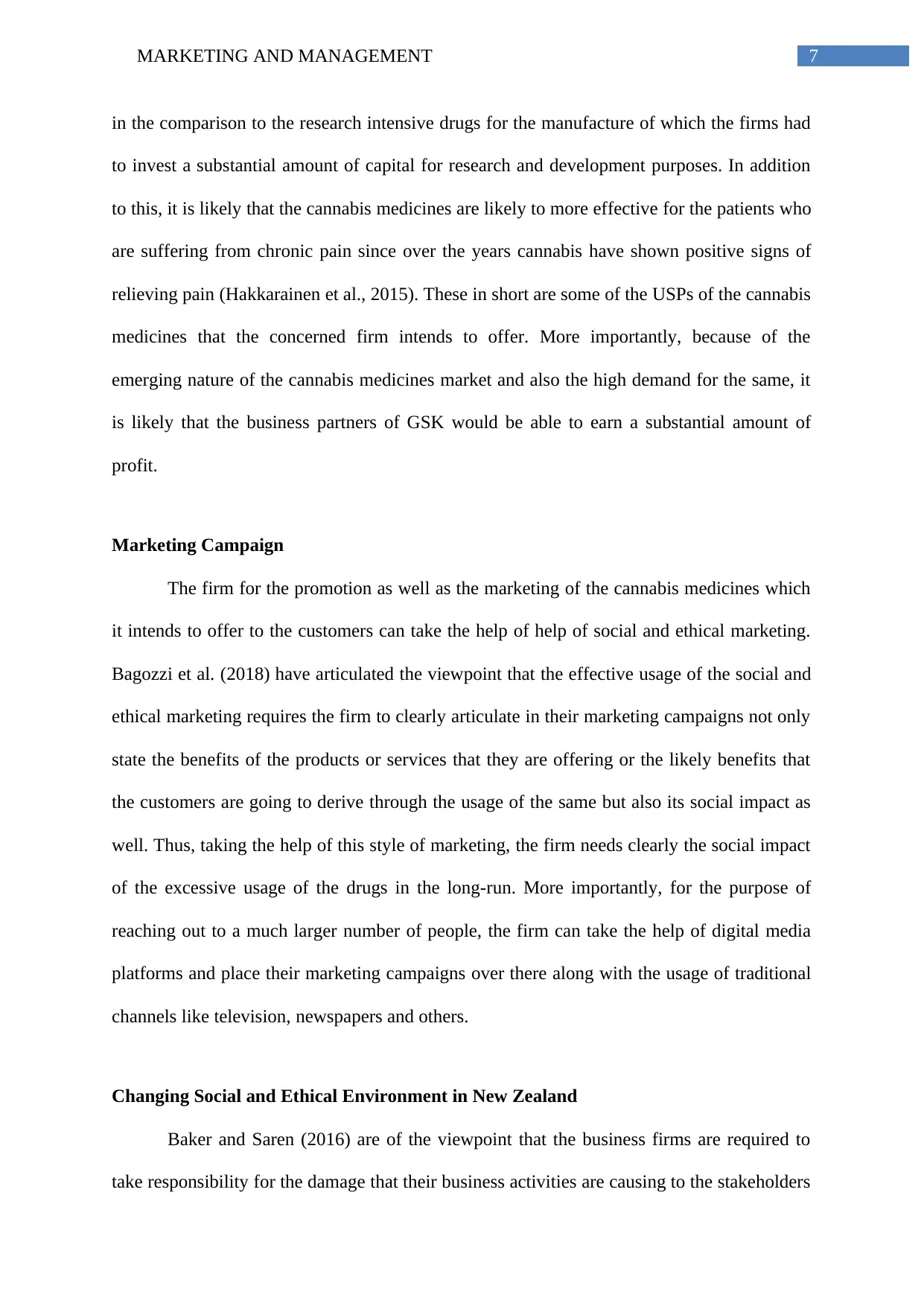
7MARKETING AND MANAGEMENT
in the comparison to the research intensive drugs for the manufacture of which the firms had
to invest a substantial amount of capital for research and development purposes. In addition
to this, it is likely that the cannabis medicines are likely to more effective for the patients who
are suffering from chronic pain since over the years cannabis have shown positive signs of
relieving pain (Hakkarainen et al., 2015). These in short are some of the USPs of the cannabis
medicines that the concerned firm intends to offer. More importantly, because of the
emerging nature of the cannabis medicines market and also the high demand for the same, it
is likely that the business partners of GSK would be able to earn a substantial amount of
profit.
Marketing Campaign
The firm for the promotion as well as the marketing of the cannabis medicines which
it intends to offer to the customers can take the help of help of social and ethical marketing.
Bagozzi et al. (2018) have articulated the viewpoint that the effective usage of the social and
ethical marketing requires the firm to clearly articulate in their marketing campaigns not only
state the benefits of the products or services that they are offering or the likely benefits that
the customers are going to derive through the usage of the same but also its social impact as
well. Thus, taking the help of this style of marketing, the firm needs clearly the social impact
of the excessive usage of the drugs in the long-run. More importantly, for the purpose of
reaching out to a much larger number of people, the firm can take the help of digital media
platforms and place their marketing campaigns over there along with the usage of traditional
channels like television, newspapers and others.
Changing Social and Ethical Environment in New Zealand
Baker and Saren (2016) are of the viewpoint that the business firms are required to
take responsibility for the damage that their business activities are causing to the stakeholders
in the comparison to the research intensive drugs for the manufacture of which the firms had
to invest a substantial amount of capital for research and development purposes. In addition
to this, it is likely that the cannabis medicines are likely to more effective for the patients who
are suffering from chronic pain since over the years cannabis have shown positive signs of
relieving pain (Hakkarainen et al., 2015). These in short are some of the USPs of the cannabis
medicines that the concerned firm intends to offer. More importantly, because of the
emerging nature of the cannabis medicines market and also the high demand for the same, it
is likely that the business partners of GSK would be able to earn a substantial amount of
profit.
Marketing Campaign
The firm for the promotion as well as the marketing of the cannabis medicines which
it intends to offer to the customers can take the help of help of social and ethical marketing.
Bagozzi et al. (2018) have articulated the viewpoint that the effective usage of the social and
ethical marketing requires the firm to clearly articulate in their marketing campaigns not only
state the benefits of the products or services that they are offering or the likely benefits that
the customers are going to derive through the usage of the same but also its social impact as
well. Thus, taking the help of this style of marketing, the firm needs clearly the social impact
of the excessive usage of the drugs in the long-run. More importantly, for the purpose of
reaching out to a much larger number of people, the firm can take the help of digital media
platforms and place their marketing campaigns over there along with the usage of traditional
channels like television, newspapers and others.
Changing Social and Ethical Environment in New Zealand
Baker and Saren (2016) are of the viewpoint that the business firms are required to
take responsibility for the damage that their business activities are causing to the stakeholders
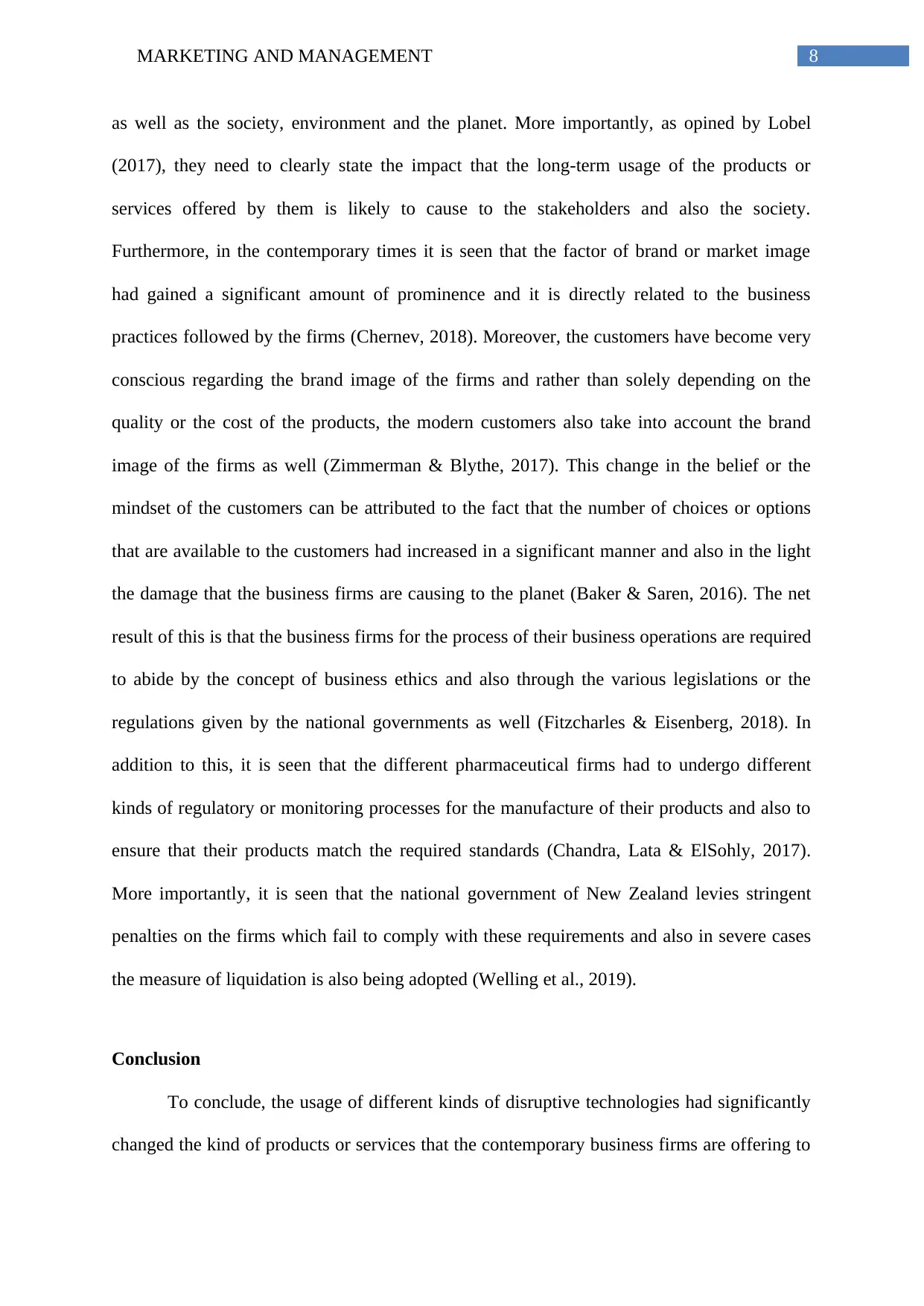
8MARKETING AND MANAGEMENT
as well as the society, environment and the planet. More importantly, as opined by Lobel
(2017), they need to clearly state the impact that the long-term usage of the products or
services offered by them is likely to cause to the stakeholders and also the society.
Furthermore, in the contemporary times it is seen that the factor of brand or market image
had gained a significant amount of prominence and it is directly related to the business
practices followed by the firms (Chernev, 2018). Moreover, the customers have become very
conscious regarding the brand image of the firms and rather than solely depending on the
quality or the cost of the products, the modern customers also take into account the brand
image of the firms as well (Zimmerman & Blythe, 2017). This change in the belief or the
mindset of the customers can be attributed to the fact that the number of choices or options
that are available to the customers had increased in a significant manner and also in the light
the damage that the business firms are causing to the planet (Baker & Saren, 2016). The net
result of this is that the business firms for the process of their business operations are required
to abide by the concept of business ethics and also through the various legislations or the
regulations given by the national governments as well (Fitzcharles & Eisenberg, 2018). In
addition to this, it is seen that the different pharmaceutical firms had to undergo different
kinds of regulatory or monitoring processes for the manufacture of their products and also to
ensure that their products match the required standards (Chandra, Lata & ElSohly, 2017).
More importantly, it is seen that the national government of New Zealand levies stringent
penalties on the firms which fail to comply with these requirements and also in severe cases
the measure of liquidation is also being adopted (Welling et al., 2019).
Conclusion
To conclude, the usage of different kinds of disruptive technologies had significantly
changed the kind of products or services that the contemporary business firms are offering to
as well as the society, environment and the planet. More importantly, as opined by Lobel
(2017), they need to clearly state the impact that the long-term usage of the products or
services offered by them is likely to cause to the stakeholders and also the society.
Furthermore, in the contemporary times it is seen that the factor of brand or market image
had gained a significant amount of prominence and it is directly related to the business
practices followed by the firms (Chernev, 2018). Moreover, the customers have become very
conscious regarding the brand image of the firms and rather than solely depending on the
quality or the cost of the products, the modern customers also take into account the brand
image of the firms as well (Zimmerman & Blythe, 2017). This change in the belief or the
mindset of the customers can be attributed to the fact that the number of choices or options
that are available to the customers had increased in a significant manner and also in the light
the damage that the business firms are causing to the planet (Baker & Saren, 2016). The net
result of this is that the business firms for the process of their business operations are required
to abide by the concept of business ethics and also through the various legislations or the
regulations given by the national governments as well (Fitzcharles & Eisenberg, 2018). In
addition to this, it is seen that the different pharmaceutical firms had to undergo different
kinds of regulatory or monitoring processes for the manufacture of their products and also to
ensure that their products match the required standards (Chandra, Lata & ElSohly, 2017).
More importantly, it is seen that the national government of New Zealand levies stringent
penalties on the firms which fail to comply with these requirements and also in severe cases
the measure of liquidation is also being adopted (Welling et al., 2019).
Conclusion
To conclude, the usage of different kinds of disruptive technologies had significantly
changed the kind of products or services that the contemporary business firms are offering to
⊘ This is a preview!⊘
Do you want full access?
Subscribe today to unlock all pages.

Trusted by 1+ million students worldwide
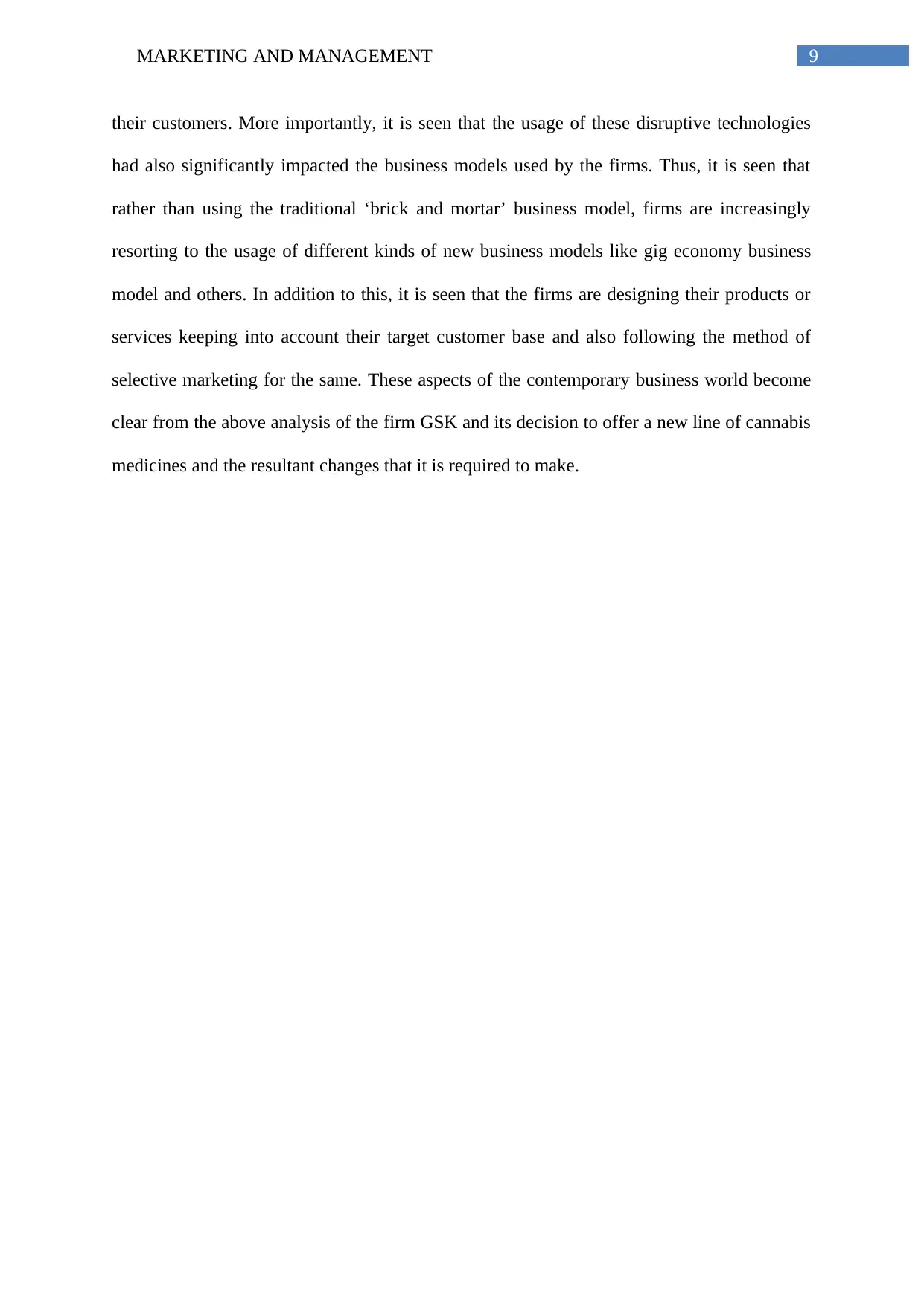
9MARKETING AND MANAGEMENT
their customers. More importantly, it is seen that the usage of these disruptive technologies
had also significantly impacted the business models used by the firms. Thus, it is seen that
rather than using the traditional ‘brick and mortar’ business model, firms are increasingly
resorting to the usage of different kinds of new business models like gig economy business
model and others. In addition to this, it is seen that the firms are designing their products or
services keeping into account their target customer base and also following the method of
selective marketing for the same. These aspects of the contemporary business world become
clear from the above analysis of the firm GSK and its decision to offer a new line of cannabis
medicines and the resultant changes that it is required to make.
their customers. More importantly, it is seen that the usage of these disruptive technologies
had also significantly impacted the business models used by the firms. Thus, it is seen that
rather than using the traditional ‘brick and mortar’ business model, firms are increasingly
resorting to the usage of different kinds of new business models like gig economy business
model and others. In addition to this, it is seen that the firms are designing their products or
services keeping into account their target customer base and also following the method of
selective marketing for the same. These aspects of the contemporary business world become
clear from the above analysis of the firm GSK and its decision to offer a new line of cannabis
medicines and the resultant changes that it is required to make.
Paraphrase This Document
Need a fresh take? Get an instant paraphrase of this document with our AI Paraphraser
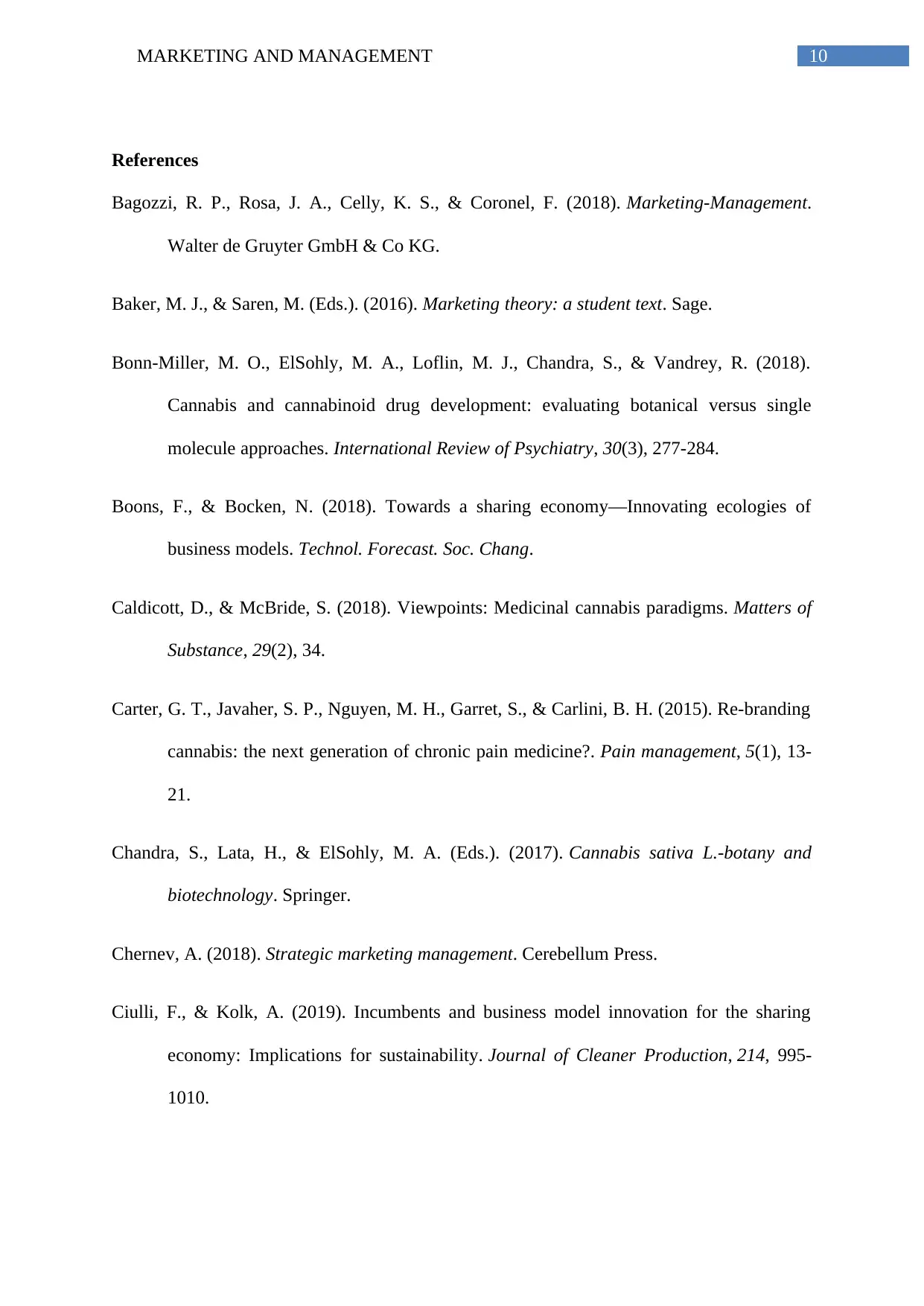
10MARKETING AND MANAGEMENT
References
Bagozzi, R. P., Rosa, J. A., Celly, K. S., & Coronel, F. (2018). Marketing-Management.
Walter de Gruyter GmbH & Co KG.
Baker, M. J., & Saren, M. (Eds.). (2016). Marketing theory: a student text. Sage.
Bonn-Miller, M. O., ElSohly, M. A., Loflin, M. J., Chandra, S., & Vandrey, R. (2018).
Cannabis and cannabinoid drug development: evaluating botanical versus single
molecule approaches. International Review of Psychiatry, 30(3), 277-284.
Boons, F., & Bocken, N. (2018). Towards a sharing economy—Innovating ecologies of
business models. Technol. Forecast. Soc. Chang.
Caldicott, D., & McBride, S. (2018). Viewpoints: Medicinal cannabis paradigms. Matters of
Substance, 29(2), 34.
Carter, G. T., Javaher, S. P., Nguyen, M. H., Garret, S., & Carlini, B. H. (2015). Re-branding
cannabis: the next generation of chronic pain medicine?. Pain management, 5(1), 13-
21.
Chandra, S., Lata, H., & ElSohly, M. A. (Eds.). (2017). Cannabis sativa L.-botany and
biotechnology. Springer.
Chernev, A. (2018). Strategic marketing management. Cerebellum Press.
Ciulli, F., & Kolk, A. (2019). Incumbents and business model innovation for the sharing
economy: Implications for sustainability. Journal of Cleaner Production, 214, 995-
1010.
References
Bagozzi, R. P., Rosa, J. A., Celly, K. S., & Coronel, F. (2018). Marketing-Management.
Walter de Gruyter GmbH & Co KG.
Baker, M. J., & Saren, M. (Eds.). (2016). Marketing theory: a student text. Sage.
Bonn-Miller, M. O., ElSohly, M. A., Loflin, M. J., Chandra, S., & Vandrey, R. (2018).
Cannabis and cannabinoid drug development: evaluating botanical versus single
molecule approaches. International Review of Psychiatry, 30(3), 277-284.
Boons, F., & Bocken, N. (2018). Towards a sharing economy—Innovating ecologies of
business models. Technol. Forecast. Soc. Chang.
Caldicott, D., & McBride, S. (2018). Viewpoints: Medicinal cannabis paradigms. Matters of
Substance, 29(2), 34.
Carter, G. T., Javaher, S. P., Nguyen, M. H., Garret, S., & Carlini, B. H. (2015). Re-branding
cannabis: the next generation of chronic pain medicine?. Pain management, 5(1), 13-
21.
Chandra, S., Lata, H., & ElSohly, M. A. (Eds.). (2017). Cannabis sativa L.-botany and
biotechnology. Springer.
Chernev, A. (2018). Strategic marketing management. Cerebellum Press.
Ciulli, F., & Kolk, A. (2019). Incumbents and business model innovation for the sharing
economy: Implications for sustainability. Journal of Cleaner Production, 214, 995-
1010.
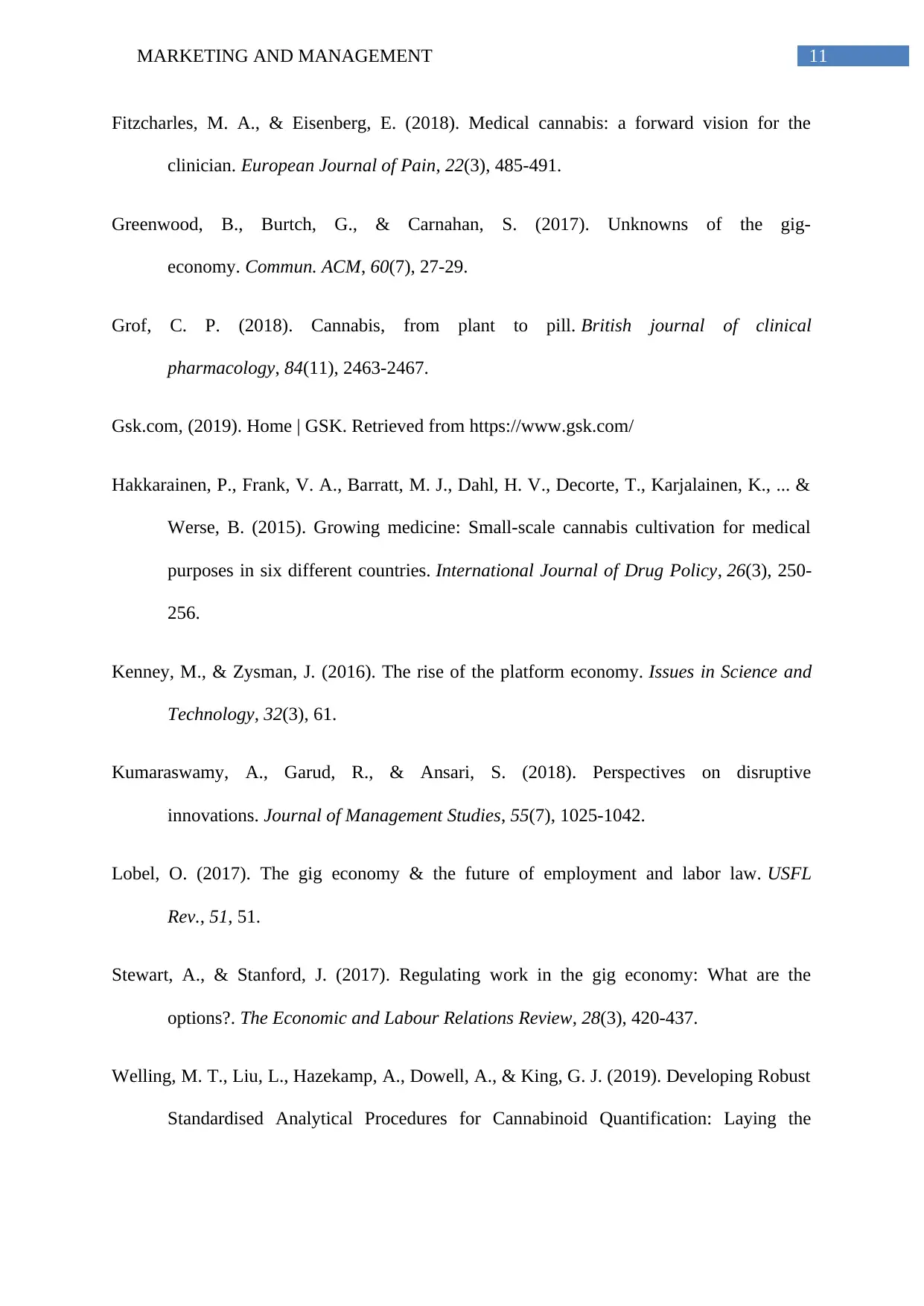
11MARKETING AND MANAGEMENT
Fitzcharles, M. A., & Eisenberg, E. (2018). Medical cannabis: a forward vision for the
clinician. European Journal of Pain, 22(3), 485-491.
Greenwood, B., Burtch, G., & Carnahan, S. (2017). Unknowns of the gig-
economy. Commun. ACM, 60(7), 27-29.
Grof, C. P. (2018). Cannabis, from plant to pill. British journal of clinical
pharmacology, 84(11), 2463-2467.
Gsk.com, (2019). Home | GSK. Retrieved from https://www.gsk.com/
Hakkarainen, P., Frank, V. A., Barratt, M. J., Dahl, H. V., Decorte, T., Karjalainen, K., ... &
Werse, B. (2015). Growing medicine: Small-scale cannabis cultivation for medical
purposes in six different countries. International Journal of Drug Policy, 26(3), 250-
256.
Kenney, M., & Zysman, J. (2016). The rise of the platform economy. Issues in Science and
Technology, 32(3), 61.
Kumaraswamy, A., Garud, R., & Ansari, S. (2018). Perspectives on disruptive
innovations. Journal of Management Studies, 55(7), 1025-1042.
Lobel, O. (2017). The gig economy & the future of employment and labor law. USFL
Rev., 51, 51.
Stewart, A., & Stanford, J. (2017). Regulating work in the gig economy: What are the
options?. The Economic and Labour Relations Review, 28(3), 420-437.
Welling, M. T., Liu, L., Hazekamp, A., Dowell, A., & King, G. J. (2019). Developing Robust
Standardised Analytical Procedures for Cannabinoid Quantification: Laying the
Fitzcharles, M. A., & Eisenberg, E. (2018). Medical cannabis: a forward vision for the
clinician. European Journal of Pain, 22(3), 485-491.
Greenwood, B., Burtch, G., & Carnahan, S. (2017). Unknowns of the gig-
economy. Commun. ACM, 60(7), 27-29.
Grof, C. P. (2018). Cannabis, from plant to pill. British journal of clinical
pharmacology, 84(11), 2463-2467.
Gsk.com, (2019). Home | GSK. Retrieved from https://www.gsk.com/
Hakkarainen, P., Frank, V. A., Barratt, M. J., Dahl, H. V., Decorte, T., Karjalainen, K., ... &
Werse, B. (2015). Growing medicine: Small-scale cannabis cultivation for medical
purposes in six different countries. International Journal of Drug Policy, 26(3), 250-
256.
Kenney, M., & Zysman, J. (2016). The rise of the platform economy. Issues in Science and
Technology, 32(3), 61.
Kumaraswamy, A., Garud, R., & Ansari, S. (2018). Perspectives on disruptive
innovations. Journal of Management Studies, 55(7), 1025-1042.
Lobel, O. (2017). The gig economy & the future of employment and labor law. USFL
Rev., 51, 51.
Stewart, A., & Stanford, J. (2017). Regulating work in the gig economy: What are the
options?. The Economic and Labour Relations Review, 28(3), 420-437.
Welling, M. T., Liu, L., Hazekamp, A., Dowell, A., & King, G. J. (2019). Developing Robust
Standardised Analytical Procedures for Cannabinoid Quantification: Laying the
⊘ This is a preview!⊘
Do you want full access?
Subscribe today to unlock all pages.

Trusted by 1+ million students worldwide
1 out of 13
Related Documents
Your All-in-One AI-Powered Toolkit for Academic Success.
+13062052269
info@desklib.com
Available 24*7 on WhatsApp / Email
![[object Object]](/_next/static/media/star-bottom.7253800d.svg)
Unlock your academic potential
Copyright © 2020–2025 A2Z Services. All Rights Reserved. Developed and managed by ZUCOL.





